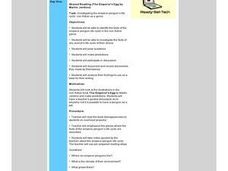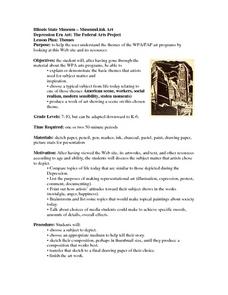Curated OER
Termite Trail Marking Behavior
Students examine termites and their trail-marking behaviors. They draw lines on paper with various ink pens and experiment to see which types of ink the termites follow--or which inks do and do not elicit trail marking behavior.
Curated OER
Falling Into Leaves
Students investigate why leaves change color. In this chlorophyll lesson, students examine how chlorophyll effects the color changes in leaves. Students take pictures of changing leaves, and create a class quilt showing the changes of...
Curated OER
Phrasal Verb Gap Fill Worksheet A-B
In this ESL phrasal verb worksheet, students read 12 sentences that have missing verbs. Students choose the best phrasal verb from the word bank that will complete each sentence.
Curated OER
Census and Redistricting
Students learn why the census makes a difference. In this U.S. Census lesson plan, students learn about the methods and politics of redistricting as they explore their local congressional districts and debate the merits of different...
Curated OER
Alchemy and Chemical Symbols
In this alchemy worksheet, students read about how alchemists kept their experiment notes in secret code. Students design their own secret code for the given elements. This worksheet has 2 problems to solve.
Curated OER
The Ins and Outs of Equilibrium
In this equilibrium worksheet, learners read about phase equilibrium and dynamic equilibrium. They answer nine questions based on their reading and their background in chemistry.
Curated OER
Being Spontaneous
In this spontaneous reactions worksheet, students read about entropy, enthalpy and Gibbs free energy. They complete a table with reaction conditions and determine if the reaction is spontaneous or not. They solve three problems about...
Curated OER
The Properties of Metals
In this properties of metals instructional activity, students read about the history of metal use and their properties. Students read about metallic bonding and answer three questions about bonding in metals.
Curated OER
Intermolecular Forces
In this intermolecular forces worksheet, students perform a simple experiment with water to observe the intermolecular forces that hold water together as they fill a beaker as much as possible. They explain the results of their...
Curated OER
Inside an Atom
In this atom worksheet, students read about the history of the discovery of the atom. Students write a story, poem, song or other creative project in which they shrink to an incredibly small size and are trapped in a carbon atom.
Curated OER
A Personal Narrative on the Immigration Experience
The students create a personal narrative on their experiences with immigration. In this lesson, students are asked to read and understand examples of narrative writing as well as evaluate lyrics from Ben Folds Five to determine elements...
Curated OER
Symbols of the World, Country and State
First graders understand what a symbol is and recognize symbols of the world, country, state, and local areas. In this symbols lesson, 1st graders identify symbols, and play a bingo game with traffic symbols. Students study the...
Curated OER
Dangers of the West
Eighth graders explore the American West. In this Westward Expansion lesson plan, 8th graders examine primary sources to investigate the dangers travelling to and settling in the American West. Students design brochures that would help...
Curated OER
What Tree is That?
Students examine leaves and the trees in their neighborhood that they came from. In this ecology lesson, students read the book, I Can Name 50 Trees Today, and discuss how a tree goes from a forest to a wood shop. Students...
Curated OER
The Emperor's Egg by Martin Jenkins
Students explore the penguin life cycle. In this penguin life cycle lesson, students read the book The Emperor's Egg by Martin Jenkins. Students look at the pictures and make predictions. Students identify facts about penguins and do...
Curated OER
Paul Conrad's Perspective on Civil Rights
Students review a political cartoon and discuss desegregation. In this cartoon analysis instructional activity, 11th graders discuss the impact of a political cartoon and its relation to a Supreme Court case. Students...
PBS
Women's History: Clara Barton
Students investigate Clara Barton's contributions to society. In this Clara Barton lesson plan, students watch videos, listen to lectures, and conduct research regarding Clara Barton's life and her possible authorship of a Civil War...
Curated OER
The Emerging American Identity
Students define what it meant to be an American early on in the nation's history. In this American identity lesson, students examine the noted quotations and determine what was meant by each of the authors with regards to an American...
Curated OER
Native American History
Students examine how Chief Joseph attempted to challenge stereotypes about Native Americans. In this Native American history lesson, students read "An Indian's Views of Indian Affairs," and then paraphrase the selection. Students also...
Curated OER
Nature Superfish
Learners study the behavior or ocean animals called billfish. In this life science lesson, students create their own documentary about a local animal. They share their videos with the entire school.
Curated OER
Images of the Parks
Students explore U.S. geography by completing a research project about the National Parks. In this scenery image analysis lesson plan, students identify the different national parks in our country and observe paintings and images by...
Curated OER
Wedge Game
Students explore the Carbon Mitigation Initiative by playing the Wedge Game. For this environmental science lesson, students discuss different strategies to reduce carbon emissions. They evaluate their strategies and rate sustainability.
National Endowment for the Humanities
The 1828 Campaign of Andrew Jackson: Territorial Expansion and the Shift of Power
Young scholars make connections between changes in voting participation and the election of 1828, and describe regional factors evidenced by the voting results of the election of 1828.
Curated OER
Depression Era Art: The Federal Arts Project
Students research Depression-era art and WPA arts programs. They discuss the purposes of representational art, list topics that would make good representational art today, and produce a work of art representing a current theme.























